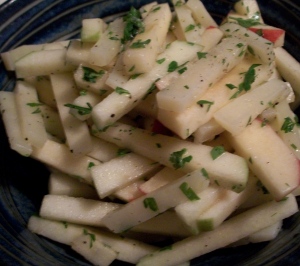So dinner’s on the stove. While it cooks, you’ve got some nuts and you’ve got some olives to nibble on. Now, what to wash them down with?
As I’ve noted that it has been noted, the last decade was a good one for cocktails. No more -tinis, no more froo-froo nonsense, just an honest appreciation for cocktails as culinary creations, as dependent on quality ingredients, balance, proportion and care as anything else that comes out of a kitchen. Needless to say, the artisanal cocktail movement has gotten out of hand in some respects, but you don’t need to wear arm garters to make a great drink.
One of my favorite pre-dinner quaffs is the Red Hook, a variation on a Manhattan which gets its name from the cherry liqueur (maraschino) that sets it apart from the standard Manhattan. Unfortunately, when I tried to purchase some Luxardo Maraschino at the only state-run liquor store in town which seems to carry it, the arm-garter crowd had beaten me to the punch and cleared out the entire shelf. Undeterred, I decided to purchase some Cherry Heering instead. Cherry Heering is a liqueur which is also popular in cocktails; unlike maraschino, which is clear, Heering is very dark, syrupy and perhaps a little too reminiscent of cherry Robitussin for some people’s taste. This being Seattle, however, where everybody is crazy for all things Scandinavian (there is actually a Leif Erikson Hall here), I figured getting a bottle of the Danish-made Heering would qualify as what the anthropologists call “going native”.
The Heering adds quite a bit of heft to this cocktail, especially when combined with a bracingly astringent vermouth like Punt e Mes, so I had to scale back the proportions of liqueur and vermouth to keep them in balance with the rye. To my taste, this cocktail hits the most important note for an aperitif: It balances sweetness with a pronounced bitterness that stimulates the palate and whets the appetite.
The hour before dinner may have never been a better time to drink.
- 2 oz. rye whiskey (especially Rittenhouse Rye, if ever they decide to sell it in the state of Washington; until then, Old Overholt will have to do)
- 1/4 oz. red vermouth, such as Punt e Mes
- 1/4 oz. Cherry Heering
Mix all of the ingredients. Pour into a glass with two ice cubes. Top with club soda if desired. Serve with something to nibble on.





























